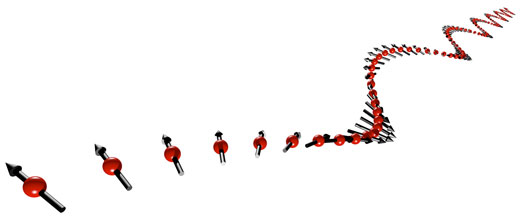| Oct 22, 2020 | |
Reviewing multiferroics for future, low-energy data storage(Nanowerk News) A new University of New South Wales (UNSW) study comprehensively reviews the magnetic structure of the multiferroic material bismuth ferrite (BiFeO3 – BFO). |
|
| The review (Advanced Materials, "The Experimentalist’s Guide to the Cycloid, or Noncollinear Antiferromagnetism in Epitaxial BiFeO3") advances FLEET’s search for low-energy electronics, bringing together current knowledge on the magnetic order in BFO films, and giving researchers a solid platform to further develop this material in low-energy magnetoelectric memories. | |
| BFO is unique in that it displays both magnetic and electronic ordering (ie, is ‘multiferroic’) at room temperature, allowing for low-energy switching in data storage devices. | |
Multiferroics: combined magnetic and electronic ordering for low-energy data storage |
|
| Multiferroics are materials that have more than one ‘order parameter’. | |
| For example, a magnetic material displays magnetic order: you can imagine that the material is made up of lots of neatly arranged (ordered), tiny magnets. | |
 |
|
| Spin (magnetic order) in the multi-ferroic material bismuth-ferrite ‘cycles’ through the crystal, offering potential application in emerging electronics fields such as magnonics. (Image: FLEET) | |
| Some materials display electronic order – a property referred to as ferroelectricity – which can be considered the electrical equivalent of magnetism. | |
| In a ferroelectric material, some atoms are positively charged, others are negatively charged, and the way these atoms are arranged in the material gives a specific order to the charge in the material. | |
| In nature, a small fraction of known materials possess both magnetic and ferroelectric order (as is the case for BFO) and are thus referred to as multiferroic materials. | |
| The coupling between magnetic and ferroelectric order in a multiferroic material unlocks interesting physics and opens the way for applications such as energy-efficient electronics, for example in non-volatile memory devices. | |
| Studies at FLEET focus on the potential use of such materials as a switching mechanism. | |
| The storage of data on traditional hard disks relies on switching each bit’s magnetic state: from zero, to one, to zero. But it takes a relatively large amount of energy to generate the magnetic field required to accomplish this. | |
| In a ‘multiferroic memory,’ the coupling between the magnetic and ferroelectric order could allow ‘flipping’ of the state of a bit by electric field, rather than a magnetic field. | |
| Electric fields are a lot less energetically costly to generate than magnetic fields, so multiferroic memory would be a significant win for ultra-low-energy electronics, a key aim in FLEET. | |
BFO: a unique multiferroic material |
|
| Bismuth ferrite (BFO) is unique among multiferroics: its magnetic and ferroelectric persist up to room temperature. Most multiferroics only exhibit both order parameters at far below room temperature, making them impractical for low-energy electronics. | |
| (There’s no point in designing low-energy electronics if it costs you more energy to cool the system than you save in operation.) | |
The study |
|
| The new UNSW study reviews the magnetic structure of bismuth ferrite; in particular, when it is grown as a thin single crystal layer on a substrate. | |
| The paper examines BFO’s complicated magnetic order, and the many different experimental tools used to probe and help understand it. | |
| Multiferroics is a challenging topic. For example, for researchers trying to enter the field, it’s very difficult to get a full picture on the magnetism of BFO from any one reference. | |
| “So, we decided to write it,” says Dr Daniel Sando. “We were in the perfect position to do so, as we had all the information in our heads, Stuart wrote a literature review chapter, and we had the combined necessary physics background to explain the important concepts in a tutorial-style manner.” | |
| The result is a comprehensive, complete, and detailed review article that will attract significant attention from researchers and will serve as a useful reference for many. | |
| Co-lead author Dr Stuart Burns explains what new researchers to the field of multiferroics will gain from the article: “We structured the review as a build-your-own-experiment starter pack: readers will be taken through the chronology of BFO, a selection of techniques to utilize (alongside the advantages and pitfalls of each) and various interesting ways to modify the physics at play. With these pieces in place, experimentalists will know what to expect, and can focus on engineering new low-energy devices and memory architectures.” | |
| The other lead author, Oliver Paull, says “We hope that other researchers in our field will use this work to train their students, learn the nuances of the material, and have a one-stop reference article which contains all pertinent references – the latter in itself an extremely valuable contribution.” | |
| Prof Nagy Valanoor added “The most fulfilling aspect of this paper was its style as a textbook chapter. We left no stone unturned!” | |
| The discussion paper includes incorporation of BFO into functional devices that use the cross coupling between ferroelectricity and magnetism, and very new fields such as antiferromagnetic spintronics, where the quantum mechanical property of the spin of the electron can be used to process information. |
| Source: ARC Centre of Excellence in Future Low-Energy Electronics Technologies (FLEET) | |
| Share this: | |
|
Subscribe to a free copy of one of our daily Nanowerk Newsletter Email Digests with a compilation of all of the day's news. |
|
